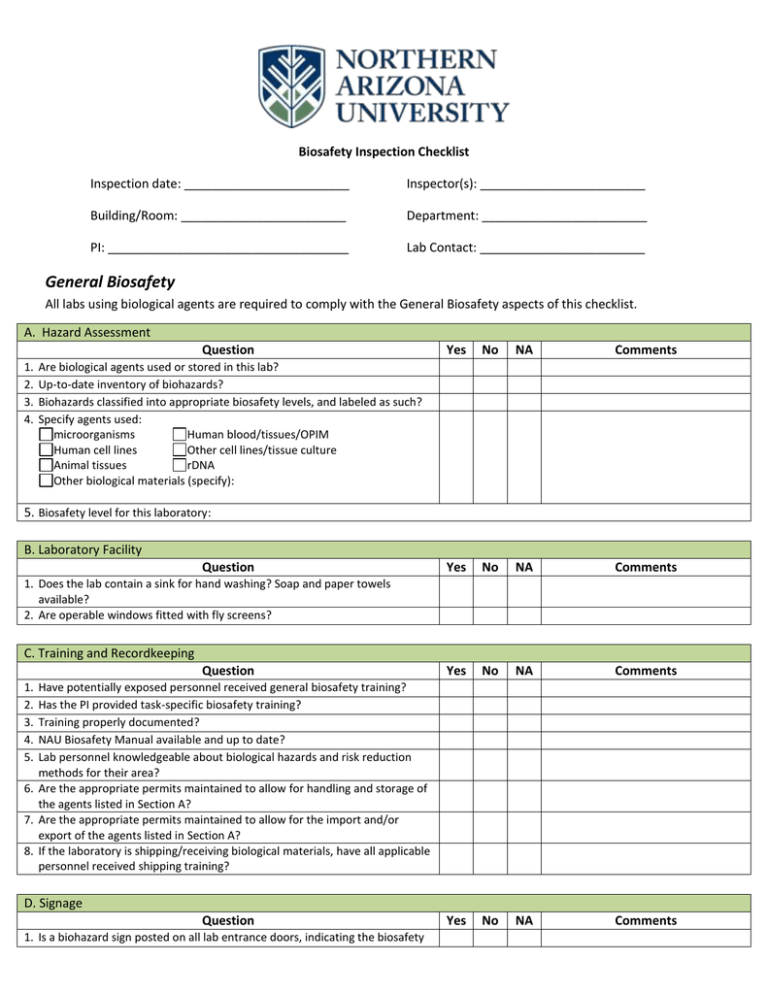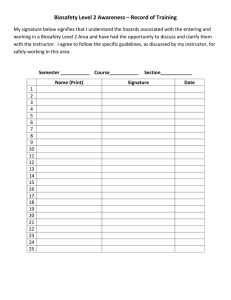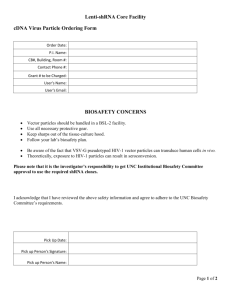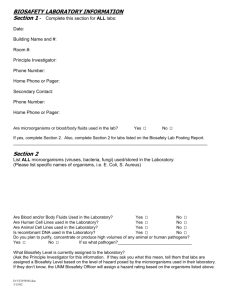Basic Biosafety Inspection Checklist
advertisement

Biosafety Inspection Checklist Inspection date: ________________________ Inspector(s): ________________________ Building/Room: ________________________ Department: ________________________ PI: ___________________________________ Lab Contact: ________________________ General Biosafety All labs using biological agents are required to comply with the General Biosafety aspects of this checklist. A. Hazard Assessment Question 1. 2. 3. 4. Yes No NA Comments Yes No NA Comments Yes No NA Comments Yes No NA Comments Are biological agents used or stored in this lab? Up-to-date inventory of biohazards? Biohazards classified into appropriate biosafety levels, and labeled as such? Specify agents used: microorganisms Human blood/tissues/OPIM Human cell lines Other cell lines/tissue culture Animal tissues rDNA Other biological materials (specify): 5. Biosafety level for this laboratory: B. Laboratory Facility Question 1. Does the lab contain a sink for hand washing? Soap and paper towels available? 2. Are operable windows fitted with fly screens? C. Training and Recordkeeping Question 1. 2. 3. 4. 5. Have potentially exposed personnel received general biosafety training? Has the PI provided task-specific biosafety training? Training properly documented? NAU Biosafety Manual available and up to date? Lab personnel knowledgeable about biological hazards and risk reduction methods for their area? 6. Are the appropriate permits maintained to allow for handling and storage of the agents listed in Section A? 7. Are the appropriate permits maintained to allow for the import and/or export of the agents listed in Section A? 8. If the laboratory is shipping/receiving biological materials, have all applicable personnel received shipping training? D. Signage Question 1. Is a biohazard sign posted on all lab entrance doors, indicating the biosafety 2. 3. 4. 5. 6. level, any required immunizations, emergency contact numbers, and any personal protective equipment that must be worn in the lab? Is the biohazard work area, if only a portion of the lab, adequately delineated from non-biohazard work space? Are the laboratory doors self-closing and have locks? Biohazard signs or labels on storage and use areas? Biohazard symbol affixed to potentially contaminated equipment? Refrigerators labeled “Not for Storage of Food for Human Consumption”? E. Risk Reduction – Work Practices, PPE, and Engineering Controls Question Yes No NA Comments Yes No NA Comments 1. Does the staff wash hands after handling viable materials, after removing gloves, and before leaving the biohazard work area? 2. Eating, drinking, smoking, applying lip balm or cosmetics, and handling contact lenses are prohibited in the work area? 3. Is food and drink stored outside the biohazard work area in a dedicated refrigerator? 4. Are procedures performed carefully to minimize splashes, sprays, and the creation of aerosols? 5. Is the lab maintained in a clean and sanitary condition? 6. Are lab coats worn in the biohazard work area? 7. Are lab coats free of visible contamination? 8. Contaminated lab coats are laundered on-site or by a suitable outside contractor; not taken home by lab personnel? 9. Lab coats removed before leaving for non-lab areas? 10. Gloves worn when handling biological agents? 11. Gloves not used when touching “clean” surfaces (telephone, keyboard, elevator buttons, door knobs)? 12. If splashes or sprays might occur, is protective eyewear available and used? 13. Respiratory protection strictly limited to voluntary use of filtering facepieces (e.g. dust masks) or particulate filtering facepieces (e.g. N95)? 14. OSHA Respiratory Protection Standard implemented when respiratory protection exceeds voluntary use of filtering facepieces)? 15. NAU Voluntary Respirator Use Information provided to all staff choosing to wear respirator protection? 16. Are Biosafety Cabinets (BSCs) available (Class I or Class II)? 17. Biosafety Cabinet(s) certified within past 12 months? 18. Are BSCs located away from doors, fume hoods, air supply, or other sources of airflow disruption? 19. Has smoke testing determined that sources of airflow disruption do not interfere with proper function of the BSC? 20. Only incidental amounts of chemicals used inside the BSC? 21. Are laminar flow hoods (“clean air benches”) located in the lab? 22. Are the laminar flow hoods used only for non-hazardous agents? 23. Are mechanical pipetting devices used? F. Disinfection, Decontamination, and Waste Question 1. Have lab personnel been offered and received appropriate immunizations for the agents potentially present in the lab (e.g. hepatitis B)? Or declined in writing? 2. Work surfaces decontaminated at least daily and immediately after spills? 3. Decontaminants effective against agents in use? 4. List decontaminants used: 5. 6. 7. 8. Written procedures in place for large and small spills or leaks? Biohazard spill kit available and properly stocked? Is an autoclave available? Are biological indicators routinely used to verify the efficacy of the autoclave? 9. Biohazardous waste placed into appropriately labeled or color-coded receptacle? 10. Waste container closed when not in use? 11. Needles/sharps placed into appropriate containers (labeled, leak-proof, puncture resistant)? 12. If materials are decontaminated outside the laboratory, are they transported in durable, leakproof containers? G. Biosafety Level 2 Question Yes No NA Comments 1. Do lab personnel have access to the CDC’s Biosafety in Microbiological and Biomedical Laboratories? 2. Is a laboratory-specific biosafety manual present and up to date? 3. Is access to the lab limited or restricted when working with infectious agents? 4. Describe method of access control (e.g. closed doors): 5. Entrance signage includes biosafety level, and any special requirements for entry (such as PPE, training, or vaccination requirements)? 6. Are medical evaluation and reporting procedures in place in the event of an exposure? 7. Can personnel describe the procedures to follow in the event of an exposure? 8. Needles are not bent, broken, removed, or otherwise manipulated by hand before disposal? 9. BSC used for procedures that might produce infectious aerosols or splashes? 10. BSC used for large volumes or high concentrations of infectious agents? 11. If viable materials are centrifuged, are safety containment cups or sealed rotors with O-rings used? 12. Are safety containment cups or sealed rotors opened only within a BSC? 13. Is whole-face protection used for procedures that must be conducted outside the BSC? 14. Sink utilizes hands-free controls (foot, knee, or automatically operated)? 15. Emergency shower/eyewash station readily available? 16. Are vacuum lines protected with a liquid disinfectant trap and HEPA filter? H. Bloodborne Pathogens (human blood, unfixed tissues, body fluids, cell lines) Laboratories using any of the above substances must comply with the General Biosafety, Biosafety Level 2, and Bloodborne Pathogens sections of the checklist Question 1. Do lab personnel have access to the NAU Exposure Control Plan? 2. Do lab personnel have access to the OSHA Bloodborne Pathogens Standard 20CFR 1910.1030)? 3. Have personnel with potential exposure received Bloodborne Pathogens training? 4. Is refresher training provided annually? 5. Have potentially exposed personnel been offered the Hepatitis B vaccine? 6. Is a Hepatitis B Vaccination Consent or Declination Form on record for all Yes No NA Comments potentially exposed personnel? 7. Are Universal Precautions employed? 8. If needles/sharps are used, is the lab enrolled in 9. Are lab personnel familiar with the emergency response procedures for spills or exposures involving rDNA material? I. Recombinant DNA Question 1. Do lab personnel have access to the NIH Guidelines for Research Involving Recombinant DNA Molecules? 2. Has the PI’s recombinant DNA research been reviewed and approved by the Institutional Biosafety Committee (IBC)? 3. Do lab personnel have access to copies of SOPs for recombinant DNA materials? 4. Is the PI familiar with which section of the NIH Guidelines their research falls under? 5. Is the rDNA experiment NIH Category III-F (exempt)? 6. Is the agent replication deficient? 7. Are lab personnel familiar with the emergency response procedures for spills or exposures involving rDNA material? Yes No NA Comments




